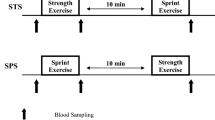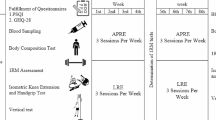Abstract
The regulatory effect of ghrelin on growth hormone (GH) is limited in describing ghrelin response to acute submaximal exercise intensities in elite athletes. We investigated the effects of a single sculling exercise performed above and below the individual anaerobic threshold (IAT) on total ghrelin concentration in highly trained male rowers. Nine elite male rowers (20.1 ± 3.7 years; 190.0 ± 5.2 cm; 89.6 ± 4.6 kg; %body fat: 9.9 ± 2.5%) volunteered for this study. Single scull rowing was performed below and above IAT using a mean of 5 bpm above and below the heart rate of the IAT during graded exercise test. Ghrelin, leptin, GH, insulin, and glucose were measured before, immediately after, and after 30 min of recovery. Plasma ghrelin concentration did not increase significantly in either exercise but was approaching significance after 30 min of recovery (P = 0.051) when the constant load sculling was performed at the intensity above the IAT. There were no changes in plasma leptin levels. GH increased significantly immediately after exercise and remained elevated during the 30 min of recovery in both exercise conditions, while insulin decreased significantly immediately after exercise and remained significantly lower after the 30 min of recovery in both exercise intensities. Baseline ghrelin was not correlated with the body composition, physical performance, or blood biochemical data. There was no significant relationship between plasma ghrelin and other blood variables immediately after the 30 min of recovery in both exercise tests and changes in ghrelin were not related to blood biochemical variables after the exercise tests. The acute constant load sculling exercise above or below IAT that increased GH concentrations did not significantly increase the circulating plasma ghrelin levels.

Similar content being viewed by others
References
Ariyasu H, Takaya K, Tagami T, Ogawa Y, Hosoda K, Akamizu T, Suda M, Koh T, Natsui K, Toyooka S, Shirakami G, Usui T, Shimatsu A, Doi K, Hosoda H, Kojima M, Kangawa K, Nakao K (2001) Stomach is a major source of circulating ghrelin, and feeding state determines plasma ghrelin-like immunoreactivity levels in humans. J Clin Endocrinol Metab 86:4753–4758
Beaver WL, Wasserman K, Whipp PJ (1986) A new method for detecting anaerobic threshold by gas exchange. J Appl Physiol 60:2020–2027
Beneke R, von Duvillard SP (1996) Determination of maximal lactate steady state response in selected sports events. Med Sci Sports Exerc 28:241–246
Bobbert T, Brechte L, Mai K, Otto B, Maser-Gluth C, Pfeiffer AFH, Spranger J, Dietrich S (2005) Adaptation of the hypothalamic-pituitary hormones during intensive endurance training. Clin Endocrinol 63:530–536
Brüning JC, Gautam D, Burks DJ (2000) Role of brain insulin receptor in control of body weight and reproduction. Science 289:2122–2125
Christ ER, Zehnder M, Boesch C, Trepp R, Mullis PE, Diem P, Decombaz J (2006) The effect of increased lipid intake on hormonal responses during aerobic exercise in endurance-trained men. Eur J Endocrinol 154:397–403
Clasey JL, Weltman A, Patrie J, Weltman JY, Pezzoli S, Bouchard C, Thorner MO, Hartman ML (2001) Abdominal visceral fat and fasting insulin are importnat predictors of 24-hour GH release independent of age, gender, and other physiological factors. J Clin Endocrinol Metab 86:3845–3852
Dall R, Kanaley J, Hansen TK, Moller N, Christiansen JS, Hosoda H, Kangawa K, Jorgensen OL (2002) Plasma ghrelin levels during exercise in healthy subjects and in growth hormone-deficient patients. Eur J Endocrinol 147:65–70
de Vries WR, Abdesselam SA, Schers TJ, Maas HC, Osman-Dualeh M, Maitimu I, Koppeschaar HP (2002) Complete inhibition of hypothalamic somatostatin activity is only partially responsible for the growth hormone response to strenuous exercise. Metabolism 51:1093–1096
Dill DB, Costill DL (1974) Calculation of percentage changes in volumes of blood, plasma and red cells in dehydration. J Appl Physiol 37:247–248
Ferguson MA, White LJ, McCoy S, Kim HW, Petty T, Wilsey J (2004) Plasma adiponectin response to acute exercise in healthy subjects. Eur J Appl Physiol 91:324–329
Foster-Schubert KE, McTiernan A, Scott Frayo R, Schwartz RS, Rajan KB, Yasui Y, Tworoger SS, Cummings DE (2005) Human plasma ghrelin levels increase during a one-year exercise program. J Clin Endocrinol Metab 90:820–825
Garcia JM, Iyer D, Poston WS, Marcelli M, Reeves R, Foreyt J, Balasubramanyam A (2006) Rise of plasma ghrelin with weight loss is not sustained during weight maintenance. Obesity 14:1716–1723
Hansen T, Dall R, Hosoda H, Kojima M, Kangawa K, Christiansen J, Jorgensen JO (2002) Weight loss increases circulating levels of ghrelin in human obesity. Clin Endocrinol 56:203–206
Haqq AM, Farooqi IS, O’Rahilly S, Stadler DD, Rosenfeld RG, Pratt KL, LaFranchi SH, Purnell JQ (2003) Serum ghrelin levels are inversely correlated with body mass index, age, and insulin concentrations in normal children and are markedly increased in Prader-Wlli Syndrome. J Clin Endocrinol Metab 88:174–178
Hartman ML (1996) Physiological regulators of growth hormone secretion. In: Juul A, Jorgensen JOL (eds) Growth hormone in adults. Cambridge University Press, Cambridge, 2 pp 3–53
Hofmann P, Bunc V, Leitner H, Pokan R, Gaisl G (1994) Heart rate threshold related to lactate turn point and steady state exercise on cycle ergometer. Eur J Appl Physiol 69:132–139
Hofmann P, Pokan R, Seibert FJ, Zweiker R, Schmid P (1997) The heart rate performance curve during incremental cycle ergometer exercise in healthy young male subjects. Med Sci Sports Exerc 29:762–768
Inder WJ, Wittert GA (2005). Exercise and the hypothalamic-pituitary-adrenal axis. In: Kraemer WJ, Rogol AD (eds) The endocrine system in sports and exercise. Blackwell Publishing, Oxford, pp 217–231
Jorgensen JO, Krag M, Kanaley J, Moller J, Hansen TK, Moller N, Christiansen JS, Orskov H (2003) Exercise, hormones, and body temperature. Regulation and action of GH during exercise. J Endocrinol Invest 26:838–842
Jürimäe J, Jürimäe T (2005) Leptin responses to a short-term exercise in college level male rowers. Br J Sports Med 39:6–9
Jürimäe J, Hofmann P, Jürimäe T, Mäestu J, Purge P, Wonisch M, Pokan R, von Duvillard SP (2006a) Plasma adiponectin response to sculling exercise at individual anaerobic threshold in college level male rowers. Int J Sports Med 27:272–277
Jürimäe J, Purge P, Jürimäe T (2006b) Adiponectin and stress hormone responses to maximal sculling after volume-extended training season in elite rowers. Metabolism 55:13–19
Kallio J, Pesonen U, Karvonen MK, Kojima M., Hosoda H, Kangawa K, Koulu M (2001) Enhanced exercise-induced GH secretion in subjects with Pro7 substitution in the Prepro-NPY. J Clin Endocrinol Metab 86:5348–5352
Kojima M, Hosoda H, Date Y, Nakazato M, Matsuo M, Kangawa K (1999) Ghrelin is a growth-hormone-releasing acylated peptide from stomach. Nature 402:656–660
Kraemer RR, Durand RJ, Acevedo EO, Johnson LG, Kramer GR, Hebert EP, Castracane VD (2004) Rigorous running increases growth hormone and insulin-like growth factor-I without altering ghrelin. Exp Biol Med 229:240–246
Leidy HJ, Gardner JK, Frye BR, Snook ML, Schubert MK, Richard EL, Williams NI (2004) Circulating ghrelin is sensitive to changes in body weight during a diet and exercise program in normal-weight young women. J Clin Endocrinol Metab 89:2659–2664
Mäestu J, Jürimäe J, Jürimäe T (2005) Monitoring of performance and training in rowing. Sports Med 35:597–617
Oh KW, Lee WY, Rhee EJ, Baek KH, Yoon KH, Kang MI, Yun EJ, Park CY, Ihm SH, Choi MG, Yoo HJ, Park SW (2005) The relationship between serum resistin, leptin, adiponectin, ghrelin levels and bone mineral density in middle-aged men. Clin Endocrinol 63:131–138
Pritzlaff-Roy CJ, Wideman L, Weltman JY, Abbot R, Gutgesell M, Hartman ML, Veldhuis JD, Weltman A (2002) Gender governs the relationship betweeen exercise intensity and growth hormone release in young adults. J Appl Physiol 92:2053–2060
Ravussin E, Tschop M, Morales S, Bouchard C, Heiman ML (2001) Plasma ghrelin concentration and energy balance: overfeeding and negative energy balance studies in twins. J Clin Endocrinol Metab 86:4547–4551
Schmidt A, Maier C, Schaller G, Nowotny P, Bayerle-Eder M, Buranyi B, Luger A, Wolzt M (2004) Acute exercise has no effect on ghrelin plasma concentrations. Horm Metab Res 36:174–177
Shintani M, Ogawa Y, Ebihara K, Aizawa-Abe M, Miyanaga F, Takaya K, Hayashi T, Inoue G, Hosoda K, Kojima M, Kangawa K, Nakao K (2001) Ghrelin, an endogeneous growth hormone secretagogue, is a novel orexigenic peptide that antagonizes leptin action through the activation of hypothalamic neuropeptide Y/Y1 receptor pathway. Diabetes 50:227–232
Takaya K, Ariyasu H, Kanamoto N, Iwakura H, Yoshimoto A, Harada M, Mori K, Komatsu Y, Usui T, Shimatsu A, Ogawa Y, Hosoda K, Akamizu T, Kojima M, Kangawa K, Nakao K (2000) Ghrelin strongly stimulates growth hormone release in humans. J Clin Endocrinol Metab 85:4908–4911
Toshinai K, Mondal MS, Nakazato M, Date Y, Murakami N, Kojima M, Kangawa K, Matsukura S (2001) Upregulation of ghrelin expression in the stomach upon fasting, insulin-induced hypoglycemia, and leptin administration. Biochem Bioph Res Commun 281:1220–1225
Tschop M, Weyer C, Tataranni PA, Devanarayan V, Ravussin E, Heiman ML (2001) Circulating ghrelin levels are decreased in human obesity. Diabetes 50:707–709
Veldhuis JD, Bowers CY (2003) Three-peptide control of pulsatile and entropic feedback-sensitive modes of growth hormone secretion: modulation by estrogen and aromatizable androgen. J Ped Endocrinol 16:586–605
Weltman A, Pritzlaff CJ, Wideman L, Considine RV, Fryburg DA, Gutgesell ME, Hartman ML, Veldhuis JD (2000) Intensity of acute exercise does not affect serum leptin concentrations in young men. Med Sci Sports Exerc 32:1556–1561
Weltman AL, Wideman L, Weltman JY, Veldhuis JD (2005) The growth hormone response to acute and chronic aerobic exercise. In: Kraemer WJ, Rogol AD (eds) The Endocrine system in sports and exercise. Blackwell Publishing, Oxford, pp 122–133
Zieba DA, Amstalden M, Morton S, Gallino JL, Edwards JF, Harms PG, Williams GL (2003) Effect of leptin on basal and GHRH-stimulated GH secretion from the bovine adenohypophysis are dependent upon nutritional status. J Endocrinol 178:83–89
Author information
Authors and Affiliations
Corresponding author
Rights and permissions
About this article
Cite this article
Jürimäe, J., Hofmann, P., Jürimäe, T. et al. Plasma ghrelin responses to acute sculling exercises in elite male rowers. Eur J Appl Physiol 99, 467–474 (2007). https://doi.org/10.1007/s00421-006-0370-y
Accepted:
Published:
Issue Date:
DOI: https://doi.org/10.1007/s00421-006-0370-y




